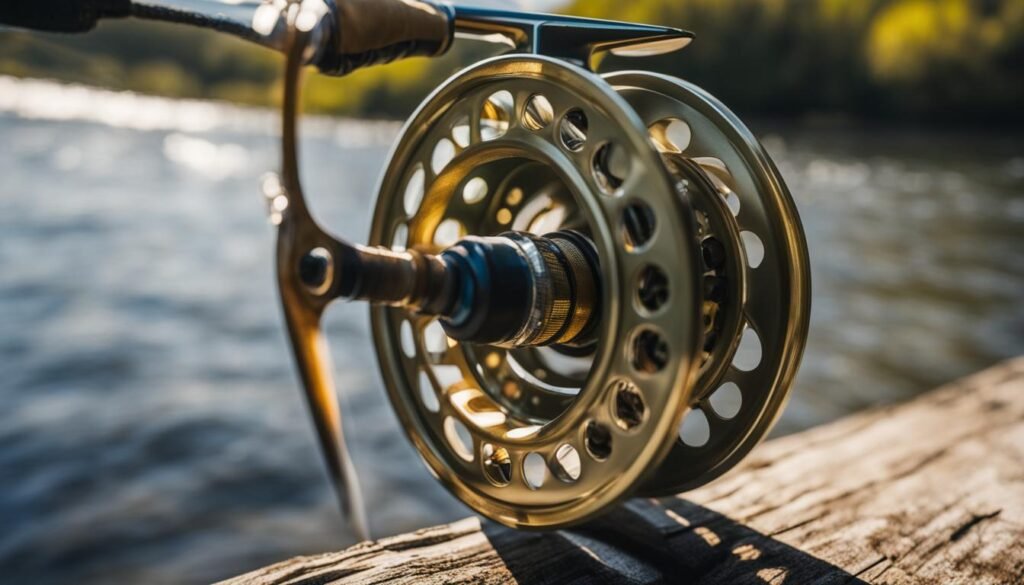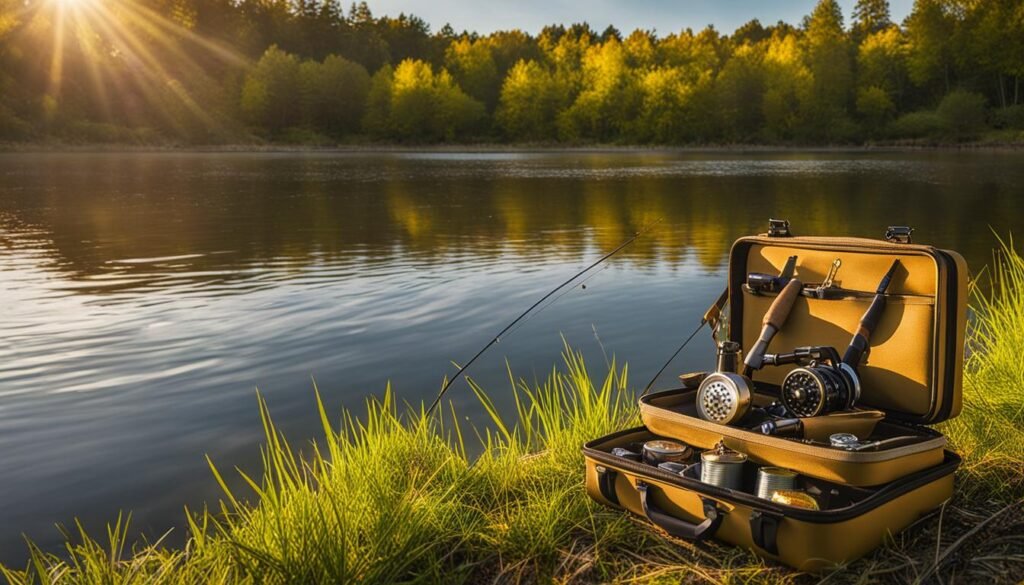Fly fishing can be an exciting and rewarding sport, but getting started can feel overwhelming with the array of gear options available. However, with the right beginner fly fishing gear, you can have a great start on the water.
DISCLAIMER: The links I mention may be affiliate links. If you purchase through one of these links I may receive a commission, at no cost to you. As an Amazon Associate I earn from qualifying purchases.
Choosing the Right Fly Rod Combo
When it comes to beginner fly fishing gear, choosing the right fly rod combo is essential. Orvis offers a range of options, including the budget-friendly Clearwater fly rod combo, designed specifically for novice anglers like you. This combo includes a fly rod, reel, fly line, and backing, providing everything you need to get started on the water.
The Orvis Clearwater fly rod combo is highly recommended for its impressive performance features. It offers versatility, manageability, and suitability for trout and bass fishing. With different sizes and weights available, you can choose the combo that best suits your specific needs and preferences.
Not only does the Orvis Clearwater fly rod combo provide exceptional quality, but it also gives you the confidence to cast with ease and precision. Whether you’re a beginner or an experienced angler looking to explore new waters, this combo is a reliable choice that won’t break the bank.
Orvis Clearwater Fly Rod Combo Specifications
| Combo Type | Fly Rod Length | Fly Line Weight | Reel Type |
|---|---|---|---|
| Clearwater | 9 feet | 5-6 | Large Arbor |
| Clearwater | 9 feet | 7-8 | Large Arbor |
| Clearwater | 9 feet | 9-10 | Large Arbor |
As you can see from the specifications table, the Orvis Clearwater fly rod combo is available in different lengths and fly line weights. This allows you to choose the combo that matches your preferred fishing style and target species. The large arbor reel design provides faster line retrieve, saving you time and effort on the water.
Essential Accessories for Fly Fishing
When it comes to fly fishing, having the right accessories can make all the difference in your experience on the water. As a beginner, it’s important to have a well-stocked fly fishing startup kit that includes essential gear to enhance your fishing success. Here are some must-have accessories for beginners:
Fly Box
A fly box is essential for storing and organizing your flies. These compact boxes come in various sizes and designs, allowing you to carry a selection of flies for different fishing situations. With a fly box, you can keep your flies organized and easily accessible, ensuring that you have the right fly at the right time. Look for a box with compartments or foam slots to securely hold your flies in place.
Here are two great options to choose:
Fly Fishing Vest
A fly fishing vest is a practical accessory that provides convenient storage for your tools, accessories, and other necessities. These vests are designed with multiple pockets and compartments, allowing you to keep your gear organized and within easy reach. Look for a vest with adjustable straps for a comfortable fit and consider one with a mesh back for breathability on hot days.
Our pick: BASSDASH Strap Fishing Vest
Waders and Wading Boots
When fishing in streams and rivers, waders and wading boots are essential for staying dry and comfortable. Waders are waterproof pants that cover your legs and torso, keeping you dry while standing in the water. Wading boots provide traction and support, allowing you to navigate slippery rocks and uneven terrain. Before purchasing waders and boots, make sure to choose the right size and fit for maximum comfort and mobility.
Fishing License
Before hitting the water, it’s important to obtain a fishing license, as it is required in most locations to legally fish. Fishing licenses help protect the fish populations and their ecosystems, ensuring sustainable fishing practices. You can typically purchase a fishing license online or at local sporting goods stores. Make sure to check the fishing regulations and license requirements specific to your area.
Choosing the Right Fly Line and Leader

Fly line and leader are crucial components of your fly fishing gear. The right fly line ensures proper casting and presentation, while a good leader helps present the fly in a natural manner. When choosing a fly line as a beginner, it’s important to match it to the weight of your fly rod.
Floating lines are commonly used in freshwater fly fishing. They stay on the surface of the water and are great for dry fly fishing. Intermediate and full sinking lines, on the other hand, are used for fishing subsurface. These lines sink at different rates and are useful for wet fly fishing and streamer fishing.
Once you’ve chosen your fly line, you’ll need a leader. The leader is attached to the end of the fly line and helps to transfer energy from the line to the fly. It is typically tapered, with the thicker end connecting to the fly line and the thinner end attaching to the tippet.
The Rio Powerflex Leader
The Rio Powerflex Leader is a popular choice among fly anglers. It is known for its excellent knot strength and abrasion resistance, making it reliable and durable. The Powerflex Leader comes in various lengths and sizes, allowing you to choose the right leader for your fishing conditions and target species. It is a versatile leader that performs well in both freshwater and saltwater environments.
The Rio Fluoroflex Tippet
In addition to the leader, you’ll also need tippet material. Tippet is added to the end of the leader, extending its length and providing a thinner, more transparent section for tying on flies. The Rio Fluoroflex Tippet is a popular choice for its strength and invisibility in the water. It is made of fluorocarbon, which has a similar refractive index to water, making it less visible to fish. The Fluoroflex tippet comes in different sizes and strengths, allowing you to match it to your leader and fly size for optimal performance.
Remember to choose the right fly line and leader for your fly fishing adventures. The right combination will help you cast with accuracy, present your fly effectively, and increase your chances of success on the water.
| Feature | Rio Powerflex Leader | Rio Fluoroflex Tippet |
|---|---|---|
| Material | Nylon | Fluorocarbon |
| Knot Strength | High | High |
| Abrasion Resistance | High | High |
| Visibility | Visible | Invisible |
| Length Options | Various lengths available | Various lengths available |
| Suitable for | Freshwater and saltwater fishing | Freshwater and saltwater fishing |
Different Types of Fly Fishing Techniques
Fly fishing offers a variety of techniques that can be used in different fishing environments and for targeting various species of fish. Understanding these techniques is essential for beginners to become successful fly anglers. Let’s explore some of the most popular fly fishing techniques:
Dry Fly Fishing
Dry fly fishing is a technique where anglers cast flies that float on the surface of the water, imitating insects that fish feed on. This technique is commonly used in trout fishing. Anglers carefully observe the water for rising fish and cast their flies upstream, allowing them to drift naturally over the fish. The visual excitement of watching a fish rise to take a dry fly makes this technique a favorite among many fly anglers.
Wet Fly Fishing
Wet fly fishing involves fishing with flies that sink below the water’s surface. These flies imitate sub-surface aquatic insects or baitfish, attracting fish that are feeding in deeper water or just below the surface. Wet flies are typically fished using a variety of techniques such as swinging, stripping, or slow retrieves. This technique is effective for targeting a wide range of species, including trout, bass, and saltwater gamefish.
Streamer Fly Fishing
Streamer fly fishing is a technique that uses larger flies imitating baitfish or other aquatic life. Streamers are designed to be fished by moving and retrieving them through the water to mimic the motion of injured or fleeing prey. This technique often produces aggressive strikes from predatory fish such as trout, bass, and pike. Streamer fishing can be particularly effective in rivers and streams with faster-moving water.
Choosing the Right Fly Reel
Fly reels are an essential component of your fly fishing gear, ensuring smooth line management and control. When selecting a fly reel as a beginner, it’s important to consider several factors to meet your specific needs and preferences.
Click-Pawl Reel vs. Disc Drag Reel
There are two main types of fly reels: click-pawl reels and disc drag reels. Click-pawl reels have a classic design and provide a traditional feel to your fishing experience. They are known for their simplicity and reliability, making them a popular choice among beginners. On the other hand, disc drag reels offer more stopping power and control. They allow you to adjust the drag to match the fighting power of the fish you’re targeting. This makes them suitable for handling larger and more aggressive species, such as trout and bass.
Consider the Arbor Size
The arbor size of a fly reel refers to the diameter of the spool. It plays a crucial role in line retrieval speed and overall performance. Larger arbor reels retrieve line faster, reducing the time it takes to reel in your catch. They also provide greater backing capacity, allowing you to handle larger fish or handle longer runs. However, smaller arbor reels are generally lighter and more compact, making them convenient for lightweight setups or situations where portability is essential.
Matching the Fly Reel to your Fly Rod
When choosing a fly reel, it’s important to match it to the weight and specifications of your fly rod. Ensuring proper balance between the reel and rod is key to achieving optimal performance and casting accuracy. Be sure to check the manufacturer’s recommendations for compatible reel options based on your fly rod model. This will help you make an informed decision and ensure a seamless combination of gear on the water.
| Reel Type | Advantages | Disadvantages |
|---|---|---|
| Click-Pawl Reel |
|
|
| Disc Drag Reel |
|
|
Fly Selection for Beginners
When it comes to fly fishing, selecting the right flies is essential for success on the water. As a beginner, it’s important to have a diverse collection of flies to match the various insects and aquatic life fish feed on. This will give you versatility and adaptability in different fishing conditions and for different target species.
For starters, it’s a good idea to have a selection of dry flies. These flies imitate insects that float on the surface, such as mayflies and caddisflies. They are great for trout and other fish that feed on the surface. Wet flies, on the other hand, imitate sub-surface insects and are effective for targeting fish that feed below the surface.
Nymphs are another type of fly that beginners should have in their arsenal. These flies imitate aquatic insects in their pre-adult stage, such as mayfly nymphs and stonefly nymphs. Nymph fishing is a popular technique for trout fishing and can be highly productive. Streamers, which imitate baitfish and larger aquatic life, are great for attracting aggressive fish like bass and pike. And if you’re looking to create surface disturbance and entice strikes, poppers are the way to go.
Remember, fly selection is not a one-size-fits-all approach. It’s important to observe the local insect activity, water conditions, and the fish’s feeding behavior to determine which flies will be most effective. By building a collection of dry flies, wet flies, nymphs, streamers, and poppers, you’ll be well-equipped to tackle a variety of fly fishing situations as a beginner.

